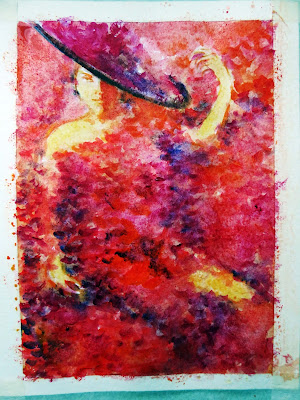One of the funnest parts of watercoloring is creating textures! I really really love to just play around with these. There are so many possibilities. Adding texture really adds interest and personality to a painting
Epsom salt "paint" creates an almost magical painting experience -- the liquid dries into crystals that look like snow or frost. The wow-worthy process happens when water evaporates out of the Epsom salt -- magnesium sulfate -- solution, leaving behind nothing but magnesium sulfate crystals
I did some previous experimentation to check in the best sal to wáter ratio, and I had good results with 1/2 tsp to 4 tsp of wáter to see sparkly crystals within the watercolor paint given a shimmery gloss effect .- to that proportion also add along a pinch of salt - (Add liquid watercolor for your desired hue and paint with that as normal you do,. the effect is produced before 24 hrs
This is the result of this process: (after 24 hrs)
Material needed;
Epsom Salts; (Magnesium sulfate) less tan 20 gr
Watercolor pencil red, orange, Brown
Watercolor tubes; crimson, burnt sienna; médium yellow, magenta, cerulean blue, violet
Round brushes
watercolor paper, cold press 220 gr
tape
2 unycel containers one with plain wáter, another with the Epson salt solution
1st Step.- I use to work loose so I feel confortable with some freehand guide lines which I do basically with watercolor pencils
Note paper has been streched previously
2nd Step.- In a plastic try I put the colors I need, and before take the paint I dip my brush in the solution to paint with it, (this part of the process is wet on wet) and tilt my paper to spread the color as I need
3rd Step.- I lift up some paint to crate forms and let it dry partially to continue mixing colors
4th Step.- Ongoing work to form shadows
5th Step.- More color
And more color (when color is wet is deep and darker)
As it dry color become less deep and is the time to reinforce colors and add definition, and here is the paint once is completed .- the effect of crystals start to appear
This is the paint after 24 hrs, the water evaporates from the solution, the epsom salts will be left behind, and will organize themselves into crystals. Small crystals will form rapidly where the epsom salt solution is thin and water evaporates from it fast. In the deeper puddles, the water takes longer to evaporate and longer, spiky crystals have more time to form
when angle the paper correctly you can catch the shimmering gloss crystals, which gives brigths into this watercolor
"The woman in the red hat, on a hot day"
Notes;
To make coloured crystals:
Mix watercolour paints with the epsom salt solution then layer onto thick white paper -- Overlapping colours will make nice effects.
It will take some time to dry, but is worth the wait to see the sparkly crystals,
Bomus painting
I did a second paint with a different ratio with 1/2 tsp Epsom salt to 1 tsp of wáter plus a pinch of normal salt .---- the crystals are better and a Little bit bigger (I did a ghost to check on White color over black colored paper .- the White used was gouache and didn´t work as good as in the watercolor paints
Close up photo of the shimmery crystals which add additional and misterious brigth to the painting























































